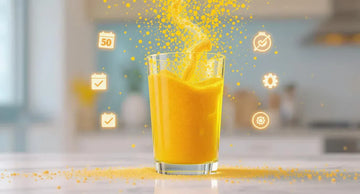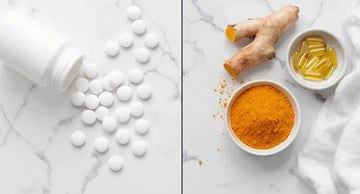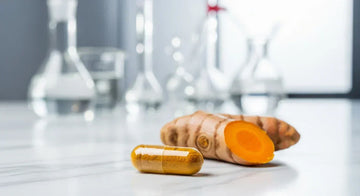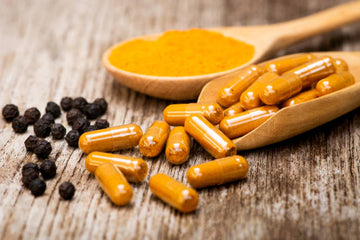The Joint Pain Revolution: Why Millions Are Switching to Turmeric
If you're dealing with arthritis or chronic joint pain, you've probably tried everything: NSAIDs, physical therapy, expensive supplements, even prescription medications. But what if the most effective solution has been hiding in plain sight?
Recent clinical studies reveal that turmeric - specifically bioavailable curcumin formulations - can significantly reduce joint pain and stiffness. Most studies report WOMAC or VAS improvements of 40-60%, comparable to NSAIDs.
Based on systematic reviews published in prestigious medical journals and recommendations from the Arthritis Foundation, here's what the science really says about natural joint pain relief that actually works.
Safety First: WHO Guidelines
The WHO/JECFA sets the acceptable daily intake at 0-3 mg/kg body weight for curcumin. For a 70kg adult, this equals up to 210mg of curcumin daily. Clinical trials commonly use 500-1000 mg/day (approximately 7-14 mg/kg), which are short-term therapeutic doses above the ADI. For long-term use exceeding 3 mg/kg, physician monitoring is recommended.
The Science Behind Turmeric for Arthritis: What Recent Studies Show
Clinical Trial Evidence Summary
| Study | Design | Participants | Duration | Key Results | Evidence Level |
|---|---|---|---|---|---|
| OA Trial (Trials, 2019) | Randomized, open-label, active-controlled | 139 knee OA patients | 28 days | BCM-95® 500mg 3x daily: WOMAC pain subscale ↓47%, function ↓43% | Moderate (no placebo) |
| RA Trial (Phytother Res, 2012) | Open-label pilot | 45 RA patients | 8 weeks | Curcumin 500mg 2x daily superior to diclofenac on DAS28 | Low (small pilot trial, needs larger double-blind confirmation) |
| Systematic Review (J Med Food, 2016) | Meta-analysis | 8 RCTs (n=606) | Various | WOMAC −15.36, VAS −2.04 (moderate clinical significance) | High |
Key Trial Details
Study #1: Osteoarthritis Trial (Open-Label Design)
- BCM-95® curcumin matched diclofenac effectiveness
- WOMAC pain reduction: 47% (curcumin) vs 44% (diclofenac)
- Better gastrointestinal safety profile
- Limitation: No placebo control
Study #2: Rheumatoid Arthritis Pilot Study
- Small pilot trial requiring larger double-blind confirmation
- Superior improvement in disease activity scores
- The trial included a third arm (curcumin + diclofenac), which also showed superior results to diclofenac alone
- Promising but preliminary results
Study #3: Systematic Review Findings
- Consistent moderate improvements across studies
- Statistical significance achieved
- Clinical relevance: moderate but meaningful
Arthritis Foundation Official Recommendation
The Arthritis Foundation recommends standardized curcumin extract 500mg taken twice daily to help control symptoms of osteoarthritis and rheumatoid arthritis.
They specifically recommend:
- Choosing bioavailability-enhanced formulations (Meriva, BCM-95, Theracurmin)
- Selecting products with third-party testing (ConsumerLab® or USP certified)
- Consulting healthcare providers before use
- Special caution with anticoagulants or diabetes medications
Why Traditional Joint Pain Treatments Often Fail
The NSAIDs Trap
Most people rely on ibuprofen, naproxen, or prescription NSAIDs. But here's the problem:
- Temporary Relief Only: Masks symptoms without addressing root inflammation
- Serious Side Effects: Stomach ulcers, kidney damage, heart risks
- Tolerance Building: Requires higher doses over time
- Cost Accumulation: $1,200+ annually for many patients
- Organ Damage: Long-term use linked to cardiovascular events
The Supplement Confusion
The joint pain supplement market is flooded with options that don't work:
- Glucosamine/Chondroitin: Mixed research results at best
- MSM: Limited bioavailability and absorption
- Traditional Turmeric: Only 3-5% absorption rate
- Combination Products: Often underdosed and ineffective
How Turmeric Breaks the Joint Pain Cycle
The Anti-Inflammatory Pathway
Curcumin targets multiple inflammatory pathways simultaneously:
- COX-2 Inhibition: Blocks pain-causing enzyme (like NSAIDs)
- NF-κB Suppression: Reduces inflammatory gene expression
- TNF-α Reduction: Lowers autoimmune inflammatory response
- IL-6 Modulation: Balances immune system response
Why Absorption Matters for Joint Pain
Traditional Turmeric Supplements:
- Most OA/RA trials use 1.5-2g daily with piperine
- Only 3-5% reaches bloodstream
- Higher doses (>2g/day) often cause GI discomfort
- Results inconsistent and delayed
Advanced Bioavailable Formulations:
- Effective dose: 500-1000mg daily (varies by formulation)
- Clinical pharmacokinetics show 10-185× better absorption (technology-dependent)*
- Direct bioavailability to joints
- Consistent, predictable results
*Different technologies achieve varying levels: micronized (~10-14×), micellar/liquid formulations (114-185×)
Your Natural Joint Pain Relief Action Plan
Important: The following suggestions should be confirmed with your doctor first, especially if you're taking anticoagulants or diabetes medications.
Week 1-2: Foundation Phase
Daily Protocol:
- Morning: 500mg bioavailable curcumin on empty stomach
- Evening: 500mg bioavailable curcumin with dinner
- Add: Gentle movement (10-15 minutes walking)
- Track: Pain levels 1-10 scale daily
What to Expect:
- Most participants notice reduced stiffness within 1-2 weeks
- First statistical significance typically seen at days 7-14 in trials
- Some individuals report subjective improvements in morning stiffness at 3-5 days
Week 3-4: Optimization Phase
Increased Activity:
- Extend walking to 20-30 minutes
- Add light stretching or yoga
- Continue consistent curcumin dosing
- Monitor sleep quality improvement
Week 5-8: Maintenance Phase
Long-term Success:
- Establish sustainable exercise routine
- Consider reducing NSAID dependence (with doctor approval)
- Monitor inflammatory markers if possible
- Adjust dosing based on activity levels
Frequently Asked Questions About Turmeric for Joint Pain
How long does turmeric take to work for arthritis?
Most participants in clinical trials notice significant improvements within 1-2 weeks, with first statistical significance at days 7-14. Some individuals report feeling reduced morning stiffness in 3-5 days, though this is anecdotal. Optimal results typically occur at 4-8 weeks.
Can I take turmeric instead of ibuprofen for joint pain?
Many people successfully reduce their NSAID usage with therapeutic curcumin. Clinical studies show curcumin can match ibuprofen's effectiveness for arthritis pain. However, work with your healthcare provider before making medication changes.
What's the best turmeric dosage for arthritis?
The Arthritis Foundation recommends 500mg of curcumin extract twice daily. Most clinical trials for OA/RA use 500-1000mg daily of enhanced bioavailability formulations. Traditional turmeric powder typically requires >2g daily to achieve therapeutic effects, often with GI side effects.
Are there any side effects of taking turmeric for joint pain?
Low doses (<2g/day) rarely cause serious side effects. Unlike NSAIDs, bioavailable curcumin doesn't cause stomach irritation, kidney problems, or cardiovascular risks at recommended doses. However:
- Piperine-combined formulations: rare cases of liver enzyme elevation reported - liver disease patients should avoid
- Those with liver disease or regular alcohol use should monitor liver function
- Pregnancy/breastfeeding: insufficient safety data available
- May interact with blood thinners and diabetes medications
Why Not All Turmeric is Equal for Joint Pain
| Factor | Traditional Supplements | Advanced Bioavailable Formulations |
|---|---|---|
| Absorption Rate | 3-5% bioavailability | 10-185× better absorption† |
| Required Dose | 1.5-2g daily (OA/RA trials) | 500-1000mg daily |
| Time to Results | 2-4 weeks | 1-2 weeks for initial benefits |
| Gastric Irritation | Common at >2g/day | Rare at recommended doses |
| Consistency | Varies by meal/timing | More predictable results |
†Data from pharmacokinetic studies; actual multiplier varies by formulation technology. Note: 1.5-2g traditional turmeric powder ≈ 45-60mg curcuminoids (~3% content)
Key References
- Shep D, et al. Safety and efficacy of curcumin versus diclofenac in knee osteoarthritis. Trials. 2019;20:214. (PMID: 30975196)
- Chandran B, Goel A. A randomized pilot study to assess efficacy and safety of curcumin in active rheumatoid arthritis. Phytother Res. 2012;26(11):1719-25. (PMID: 22407780)
- Daily JW, et al. Efficacy of turmeric extracts and curcumin for alleviating symptoms of joint arthritis. J Med Food. 2016;19(8):717-29. (PMID: 27533649)
- Schiborr C, et al. The oral bioavailability of curcumin from micronized powder and liquid micelles. Mol Nutr Food Res. 2014;58(3):516-27. (PMID: 24402825)
- WHO/JECFA. Curcumin ADI 0-3 mg/kg body weight. 44th meeting report.
- Arthritis Foundation. Turmeric. Available at: arthritis.org/health-wellness/healthy-living/nutrition/anti-inflammatory/turmeric
The Bottom Line on Turmeric for Arthritis
The scientific evidence supports turmeric (specifically bioavailable curcumin) as a legitimate option for arthritis pain and inflammation management. With recommendations from the Arthritis Foundation and clinical studies showing results comparable to NSAIDs (40-60% improvement in pain scores), it represents an evidence-based natural alternative.
Success depends on choosing properly formulated products with clinical evidence. Look for:
- Published research on the specific formulation
- Third-party testing (ConsumerLab® or USP certification)
- Bioavailability enhancement technology
- Appropriate dosing (500-1000mg curcumin daily)
If you're tired of masking symptoms with NSAIDs or concerned about their long-term risks, bioavailable curcumin offers a safer alternative worth discussing with your healthcare provider.








